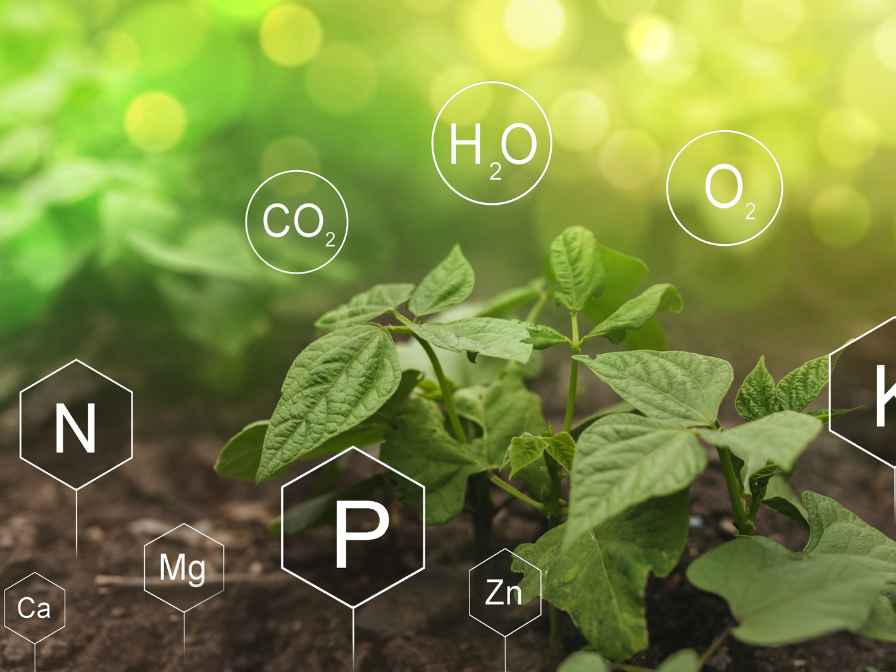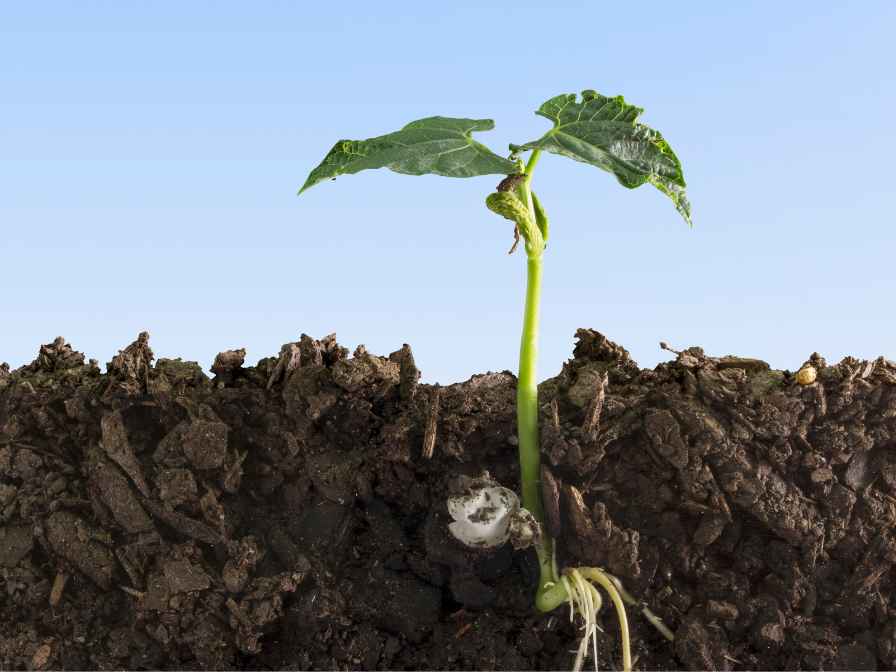Understanding which part of the plant absorbs most of the water and mineral taken up from the soil is very important. It is because when plants fell prey to any of the diseases or pests it is the main part of the plant which gets affected. If we know it better, we would be able to adopt the best remedial practices.

Part of Plants That Absorb Most of the Water and Minerals
Contrary to the thought of many people, there is not one part of the plant, that absorbs minerals from the soil to the other parts of the plants. There are three main parts of the plants that do these tasks.
One of the main parts is the roots. The other parts which absorb water and minerals are the stems and leaves of the plants. These all are explained as follows:
Roots
Roots get water and minerals from the soil through a process called “root absorption.” The roots of plants have specialized cells, called root hairs, which increase the surface area of the roots and allow them to absorb water and minerals more effectively.
Osmosis is a mechanism by which water travels from a region of high water concentration) to an area of low water concentration, allowing it to enter the root hairs.
By a process known as active transport, minerals like nitrogen, phosphorus, and potassium are moved over the cell membrane and into the plant by the root cells, where they are then absorbed by the root hairs.
Once inside the root, the water and minerals are transported up through the stem and into the leaves, where they are used for photosynthesis and other metabolic processes. Excess of the water is released by the plant under the process of transpiration through the small opening of the stomata.
Stems
Stomata, which are tiny holes or apertures on the surface of leaves, stems, and other plant organs, allow for the exchange of gases and water vapor with the environment in stems. Stomata do not, however, directly take up water and minerals for the plant from the soil.
The roots of plants absorb minerals and water through a process called root absorption. Once absorbed, they are transported up through the stem and into the leaves through a system of interconnected vessels called the xylem.
The movement of water and minerals through the xylem vessels is driven by a combination of factors, including transpiration, root pressure, and capillary action, as described in my previous response.
In a process known as transpiration, stomata play a part in controlling the quantity of water that exits the plant. Water vapor can exit the plant through the leaves while the stomata are open. As previously mentioned, this water loss via the stomata generates a negative pressure that draws water up from the roots, through the stem, and into the leaves.
Leaves
Leaves play a crucial role in the growth and development of plants by absorbing water and minerals through specialized structures called stomata. Also, the process of photosynthesis is also done through the leaves, which is important for plants as well as for humans.
To exchange gases and water vapor with the environment, leaves have microscopic holes called stomata on their surface. Water is drawn up from the roots, through the stem, and into the leaves when the stomata are open, allowing water vapor from the plant to escape via the leaves and produce negative pressure.
Water and minerals are utilized for a number of things once they are within the leaves, including photosynthesis, which is the process by which plants use energy from sunlight to change carbon dioxide and water into glucose (sugar) and oxygen.
Photosynthesis is essential for plant growth and provides the energy needed for the plant to carry out other metabolic processes. In summary, leaves play a critical role in plant growth by absorbing water and minerals through stomata, which are then transported through the xylem to other parts of the plant.
These nutrients are essential for photosynthesis and other metabolic processes that are important for the development and growth of trees and plants. Overall, these leaves play an important role in the development of plants.
Taking care of Roots, Leaves, and Stems

It is important to take good care of the parts of the plants that absorb water and minerals from the soil. the important ones are roots. While the other one includes the stems and leaves.
Taking Care of Roots
Ensure that your plants are potted in the right soil type. Different plants require different soil types for optimal growth. Also, regular watering is crucial for the health of plant roots. Water your plants deeply but not too frequently, and make sure the soil has good drainage to avoid waterlogging.
Moreover, you can use organic or inorganic fertilizers to provide your plants with the necessary nutrients. As plants grow, their roots need more space to grow. Repotting your plants periodically will ensure that they have enough room for healthy root growth.
When the roots of the plant become too large for their pot, it can cause the plant to become root-bound. This can lead to stunted growth and other problems. Regular repotting can help prevent this problem. Over-watering can lead to root rot, which can be fatal for your plants. Make sure that the soil is moist, but not waterlogged.
Taking care of stems
Some plants have weak stems that require support. You can use stakes or trellises to provide support for these plants. Regular pruning of stems can help promote healthy growth and prevent disease. Remove any damaged or diseased stems to promote new growth.
Proper watering is essential for healthy stem growth. Make sure to water your plants deeply, but not too frequently, and avoid getting the leaves wet as it can promote disease. Use organic or inorganic fertilizers to provide your plants with essential nutrients.
Protect your plants from harsh weather conditions such as wind and extreme temperatures. You can use barriers or covers to protect your plants from these conditions. Be careful when handling your plants to avoid damaging the stems. Avoid stepping on or pulling the stems, as this can damage them and affect plant growth.
Taking care of leaves
Leaves play a vital role in photosynthesis and plant growth, and taking care of them is essential for the overall health of the plant. Here are some tips on how to take care of plant leaves:
Proper watering is essential for healthy leaf growth. Water your plants deeply but not too frequently, and avoid getting the leaves wet as it can promote disease. Plants need nutrients for healthy growth, and fertilizing can provide them with these nutrients
Regularly cleaning your plant’s leaves can help remove dust and debris that can affect photosynthesis. You can use a damp cloth or spray bottle of water to clean the leaves gently. Pests such as aphids, spider mites, and whiteflies can damage your plant’s leaves. You can use organic or chemical insecticides to control these pests.
Pruning can help promote healthy leaf growth and remove any diseased or damaged leaves. Prune your plants regularly to encourage new growth. Plants need light for photosynthesis, and inadequate light can affect leaf growth. Make sure your plants receive enough light for healthy growth.
In short, it is very important to understand and realize the important part of plants, which absorb minerals and water from the soil, or from the surroundings. It is because then you would be able to take good care of them, and finally, you will get plants and a good yield.
FAQs
Why do plants need to absorb minerals?
Water and minerals are very essential parts of plant growth. It is because, like the human body, plants are not able to produce by themselves. Then they get these minerals from the soil. There are many minerals according to use for growth, good plant yield, etc.
What happens to plants without minerals?
As humans, if plants will not get the required amount and a required specific nutrient from the soil, in any form they will not show the desired growth and results. Then you would see that plant is showing the symptoms of weakness and it may end up dying.
What do plants need roots for?
Roots are the primary part of the plant. The roots not only provide the base for the plant in the soil, but roots also keep the plant stable in the soil. also, roots help the plant in growing and these roots also absorb water and minerals from the soil which are essential for the good growth of the plants.

